
Do you want to grow a Whale Fin Snake Plant but don’t know where to start? Or do you already have one but you need some extra advice? Then this ultimate Whale Fin plant care guide is the perfect read for you. Read on to get all the care tips and expert advice to grow a tall and healthy plant.
| Botanical Name (Latin Name/Scientific Name): | Sansevieria Masoniana |
| Common Name: | Whale Sansevieria, Whale Snake Plant, Sansevieria Masoniana, Whale Sansevieria |
| Light: | low light tolerant |
| Watering: | when the soil dries out to the bottom of the pot |
| Soil: | succulent or cacti mix |
| Repotting: | Once a year |
| Fertilizing: | once every 2-4 weeks with a succulent fertilizer |
| Temperature: | 18 to 24 C° (65 to 75 F°) |
| Humidity: | optimal 5% to 25%, but adapts well to any humidity level |
| Toxicity for Pets: | Toxic to cats and dogs (nausea, vomiting, diarrhea) |
| Toxicity for Humans: | Toxic (vomiting, diarrhea, dermatitis) |
| Propagation: | Leaf cuttings in water, leaf cuttings in soil, division, rhizome cuttings and seed propagation |
| Pruning: | Prune dead or diseased growth |
Light Requirements
| Minimal amount of light: | 50 lux (5 FC) |
| Optimal amount of light: | 750+ lux (75+ FC) |
| Direct sun tolerance: | 5-6 hours |
| Category: | low-light tolerant |
Whale Fin Sansevieria prefers medium indirect light (light over 750 lux / 75 foot candles) and it can tolerate 5-6 hours of direct sunlight per day. If you can’t provide these light levels, Whale Fin Snake Plant can survive even in lower light, as low as 50 lux, but the new growth will be long and leggy. The more light you provide, the happier your plant will be. More light enhances photosynthesis and makes the Whale Fin Sansevieria plant more resistant to pests and diseases.

Snake plant grown for several years in 10,000+ lux
Can Whale Fin Snake Plant Tolerate Very Low Light?
Yes, Whale Fin Snake Plant can tolerate very low light, as low as 50 lux. It will live in low light, but it will not thrive. In low light new growth will be small and leggy and the leaves will be etiolated (stretched). For a healthy and good looking Whale Fin plant, aim for medium indirect light (light over 750 lux).
Watering Sansevieria Masoniana
Water Sansevieria Masoniana once the soil is fully dry, all the way to the bottom of the pot. To check the soil, stick a chopstick inside it, push it gently all the way down, and pull it out. If the chopstick comes out dry, with no soil attached to it, it’s time to water. If the chopstick comes out wet or dirty, with soil attached, this means the soil is still wet and you should hold off with watering. If you’re unsure, wait another week. With snake plants, it’s always better to go on the side of underwatering. They are drought-tolerant and can survive even a few months without water if needed.
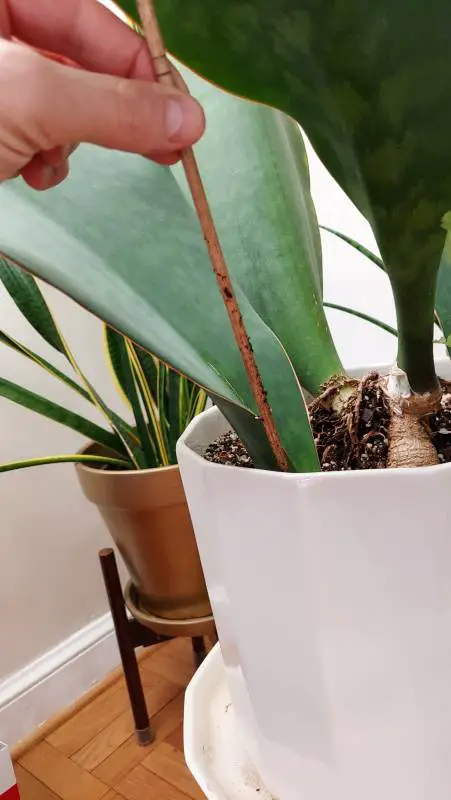
What Does an Underwatered Sansevieria Masoniana Look Like?
An underwatered Masoniana usually has a leaf that will start curling, as presented in the image below. Not all whale fins will do that. If the fins don’t close, then they will tilt to the side. After watering, the leaves will uncurl and return to their original position within a couple of hours.
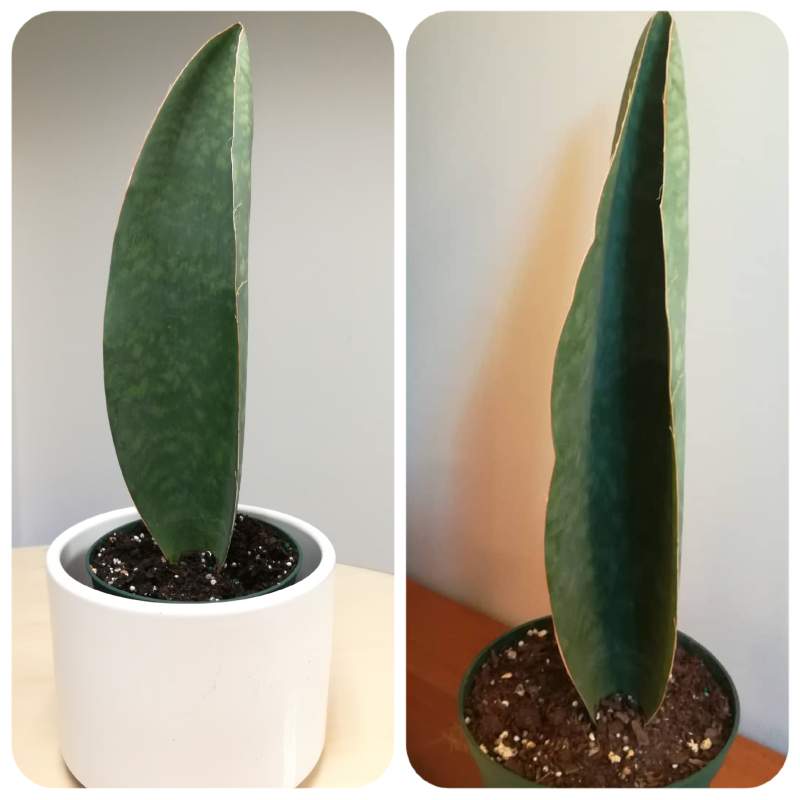
Comparison of watered and underwatered Whale Fin Snake Plant (after 2 months without water). Whale Fin Sansevieria care requires to check your plant and water once the soil is completely dry.
See what an underwatered Whale Fin Snake Plant looks like in the video below:
Whale Fin Sansevieria Humidity
The optimal humidity for Whale Fin Sansevieria plant is between 5% and 25%. However, the plant adapts well to any humidity level. Even if the humidity in your home is over 70%, your plant will do just fine.
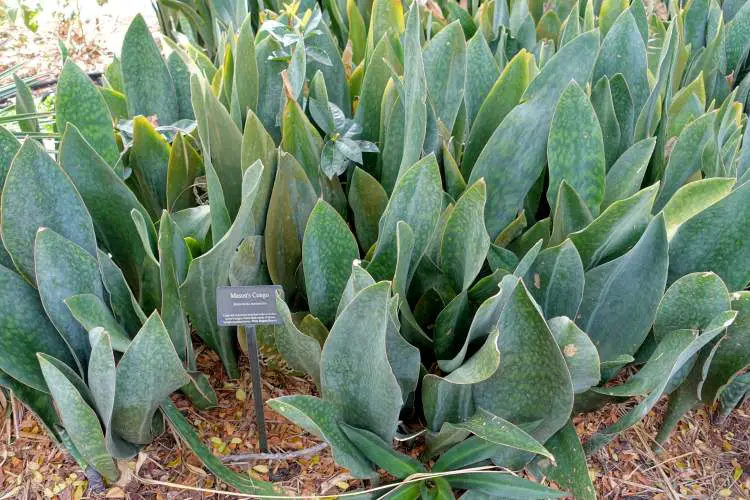
Whale Fin Snake Plant growing in a botanical garden
Whale Fin Sansevieria Temperature Needs
The optimal temperature for Whale Fin Sansevieria care is between 18 to 24 C° (65 to 75 F°). Avoid temperature drops below 16C (60 F). They will not harm the plant but will slow down root development and leaf development.
Fertilizing Whale Fin Snake Plants
Fertilize Whale Fin Snake Plants with a low-nitrogen succulent fertilizer once every 2 to 4 weeks. When fertilizing, make sure to follow the instructions on the fertilizer packaging and do not use more fertilizer than listed on the packaging.
An excellent succulent fertilizer is Espoma Succulent and Cacti Fertilizer. It is a low-nitrogen fertilizer with an N-P-K ratio of 1-2-2.
Please note that fertilizing Whale Fins is not necessary if you repot the plant annually. By repotting annually, fresh soil will provide your plant with nutrients.
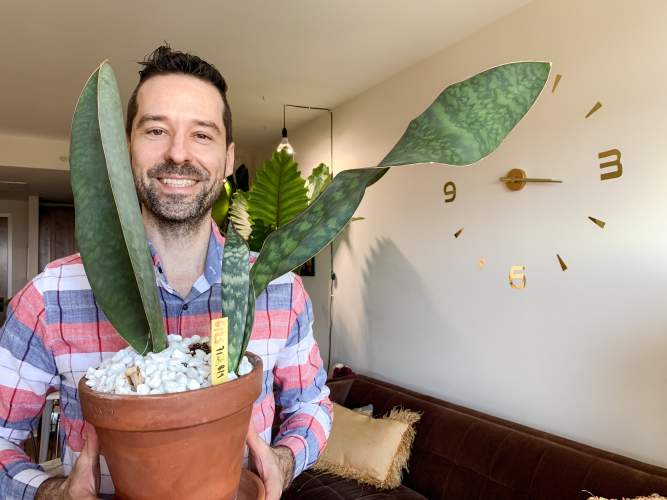
Light and fertilizer will help you grow a happy Whale Fin Sansevieria plant
Never fertilize a plant when it’s not growing. Since the plant won’t be able to use the nutrients, they will accumulate in the soil. And over time, they can burn the roots and damage the Whale Fin plant.
Soil
The best soil for Whale Fin plant is soil that dries out quickly between watering. This type of soil is called well draining soil. You can make a well draining soil mix by mixing 1 part any store-bought potting mix and 1 part perlite, pumice, or coarse sand.
Store-bought potting mix in most cases is not well-draining. They retain too much water. This means the soil dries out much slower which increases the chances of root rot. That’s why you need to amend them with perlite, pumice or coarse sand to make them well-draining.
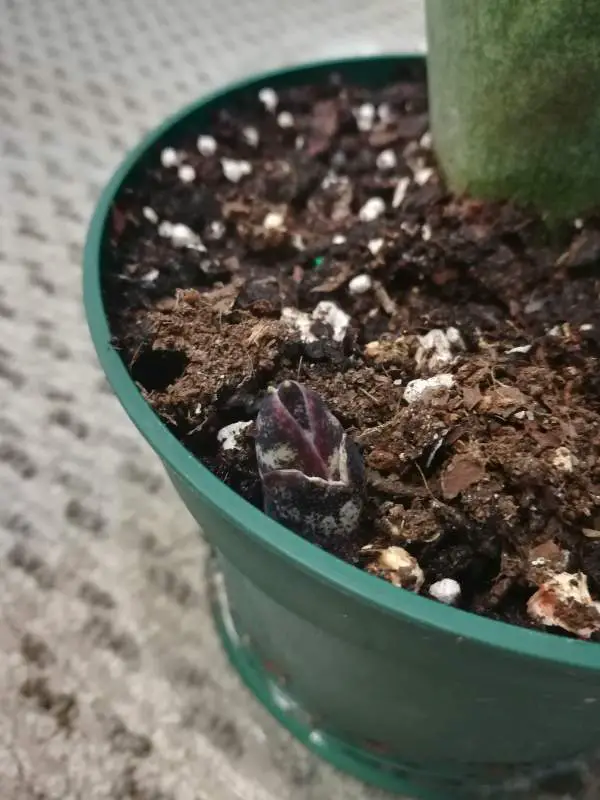
Potting mix for Whale Fin Sansevieria requires soil with perlite and bark
Another disadvantage of store-bought potting mixes is they mostly consist of peat moss or coco coir. Peat moss and coco coir consist of very tiny particles. These particles compact over time. When they get compacted, there isn’t much room for oxygen. And the lack of oxygen is the perfect environment for the development of bacteria or fungi that can cause root rot.
In the video below you can check how to make a potting mix for the Snake plants:
How to Repot Whale Fin Sansevieria?
To repot Whale Fin Sansevieria follow these steps:
- Take the plant out of its pot
- Lightly loosen the rootball
- Inspect the roots
- Cut off dead, soft, mushy roots, if any
- Fill up 1/3 of the new pot with fresh soil (choose a pot with a drainage hole)
- Place the snake plant into the new pot
- Fill the pot with soil
- Press the soil lightly around the plant
- Water if the soil has been dry before repotting
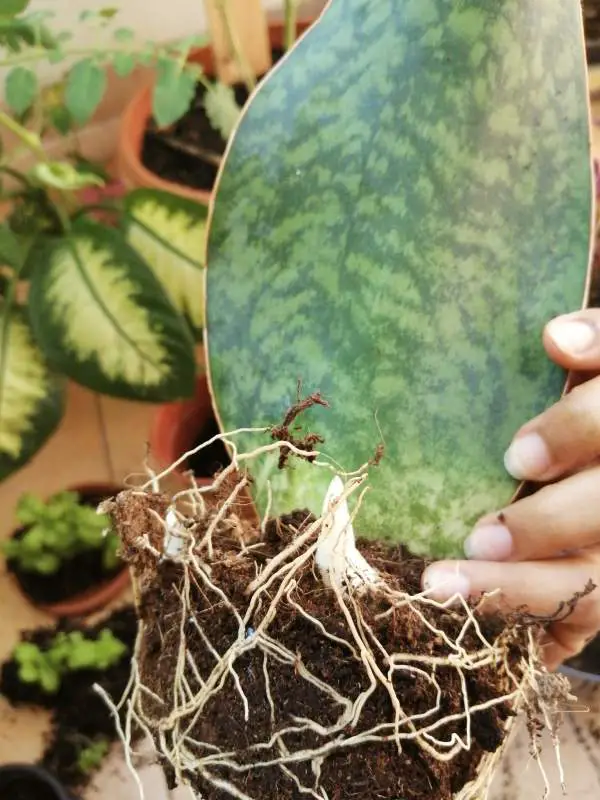
Repotting of a Whale Fin plant
To see how to repot Whale Fin Sansevieria, check out the video below:
Toxicity To Pets
Snake plants contain saponin which is toxic to pets if ingested, according to the American Society For Prevention Of Cruelty To Animals (ASPCA). They aren’t lethal but can cause great discomfort to your furry friend. The usual symptoms are severe pain, vomiting, nausea, increased saliva, and diarrhea. So, unfortunately, whale fin plant isn’t a pet-friendly plant.
Toxicity To Humans
Whale fin plants are toxic to humans when ingested and can cause minor illnesses such as vomiting or diarrhea, according to the University of California’s Division of Agriculture and Natural Resources. Snake plants can also cause dermatitis – skin rash or irritation.
If ingested, call the Poison Control Center or your doctor.
Pruning
Healthy whale fin snake plants don’t need to be pruned. Only prune dead or diseased growth or if you want to take a cutting for propagation.
Propagation
You can propagate Whale Fin Sansevieria through leaf cuttings in water or soil, division, rhizome cuttings and seeds. Continue reading for propagation tips and methods.
Propagation Through Leaf Cuttings In Water
To propagate a Whale Fin Snake Plant through leaf cuttings in water follow these steps:
- Cut off a whole leaf (or cut off a single leaf into several sections)
- Place the cut leaf in a propagation dish with water (Make sure to keep the same leaf orientation. If you turn a leaf upside-down, it won’t be able to absorb moisture and will die)
- Put the propagation dish in bright indirect light (over 10,000 lux)
- Replace water weekly to replenish oxygen and remove harmful bacteria
- Once the cuttings grow 2-3 inches of roots, pot them in soil
- In soil, water once the soil is 100% dry
- In a few months to 1 year, a new leaf will grow
Using a heat mat or an air pump will speed up water propagation. A heat mat will increase the temperature of the water and speed up propagation. An air pump will provide oxygen for new roots. It will also cut the propagation time in half and reduce the need to replace water.
To see Whale Fin Snake Plant leaf cutting propagation in water, check out the following video:
After a few months in water, the cuttings grew roots and several new shoots. To see an update, check out the video below:
To see how to pot propagated leaf cuttings in soil, watch the following video:
Propagation Through Leaf Cuttings In Soil
To propagate a Whale Fin Sansevieria through leaf cuttings in soil follow these steps:
- Cut off a whole leaf (or cut off a single leaf into several sections)
- Fill a shallow pot with a well draining soil mix (1 part soil, 1 part perlite)
- Pot the cut leaf in the pot (Make sure to keep the same leaf orientation. If you turn a leaf upside-down, it won’t be able to absorb moisture and will die)
- Put the pot in warm spot with bright light (over 10,000 lux)
- Water once the soil is 100% dry
- If the soil stays wet longer than a few days, increase light and repot to a terracotta pot
- In a few months to 1 year, a new leaf will grow
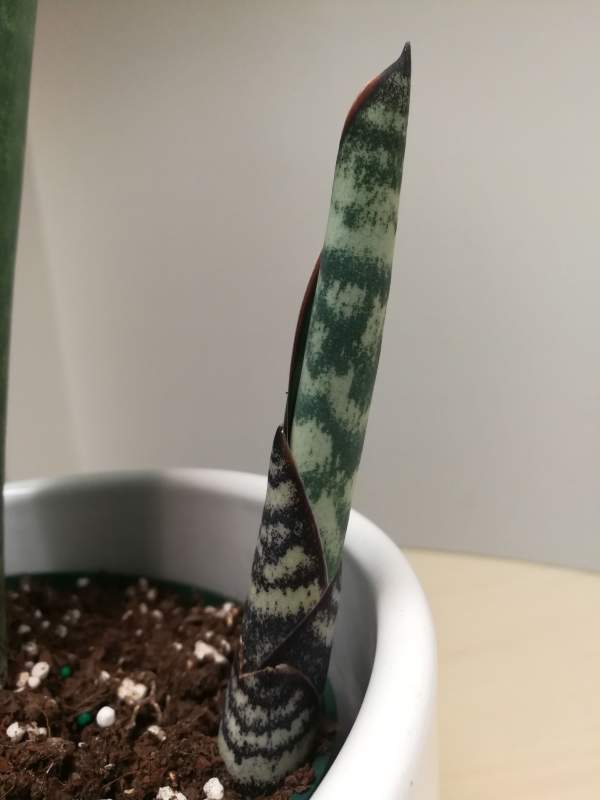
New pup growing from a propagated Whale Fin Sansevieria leaf
Propagation Through Division
If your Whale Fin Snake Plant has more than 1 leaf in the pot, you can propagate it through division. Division is separating the two leaves at the root level and potting them individually. By doing this, you will get two separate plants. To propagate a Whale Fin Sansevieria through division, follow these steps:
- Take the Whale Fin Sansevieria out of the pot
- Remove just enough soil to expose the rhizome connecting the 2 plants
- Take a sterilized knife
- Cut the rhizome in the middle, between the 2 leaves. You can also break it off with your hands
- Leave both plants for a day or two so the cut rhizomes dry out
- Pot the leaves in individual pots
Propagation Through Rhizome Cuttings
To propagate a Whale Fin Sansevieria you don’t have to cut off your plant’s beautiful leaves. You can use a piece of the rhizome to create a new plant. To propagate a Whale Fin Sansevieria through rhizome cuttings, follow these steps:
- Take the Whale Fin Sansevieria out of the pot
- Remove soil to expose the rhizome (thick fleshy roots)
- Take a sterilized knife
- Cut off a part of the rhizome (the bigger the better)
- Leave the rhizome for a few days so the wound can heal
- Pot the rhizome in a shallow dish with well-draining soil mix (1 part soil, 2 parts perlite)
- Keep the pot in a warm place
- Water once every 2-4 weeks (make sure the soil is fully dry before watering and don’t let the soil stay moist longer than a week)
- In several weeks, the rhizome will develop roots
- In several months to 1 year, it will grow a new leaf
The speed of propagation and the leaf size will depend on the size of the original rhizome cutting. A bigger rhizome will have more energy and be able to produce a larger leaf.
But the key in the propagation process is to not keep the rhizome moist for longer than 1 week. You can avoid this by using a heat mat. A heat mat will increase soil temperature by several degrees. It will speed up drying of the soil. And it will help the rhizome grow roots faster.
Propagation Through Seeds
Even though Whale Fin Sansevieria can be propagated through seeds, it takes a long time for the plant to flower. It also takes a long time to grow a plant from seeds. Leaf cuttings, division and root cuttings are much faster and easier ways to propagate it.
How Long Does It Take To Propagate Sansevieria Masoniana?
Sansevieria Masoniana is a slow grower. It takes several months to 1 year to propagate it.
Pests
Scale Pests
Whale Fin Sansevieria plant is generally pest free, but it can occasionally get infested with scale. The best way to get rid of scale is to scrape off physically as many scales as you can. Then treat the whole plant with insecticidal soap, horticultural oil, or neem oil.
These products work better against soft scales than armored scales. Armored scales are protected by their armor, so the products might not penetrate it. Your best bet is to apply them when scales are young. Another way to get rid of scales is to use a systemic insecticide.
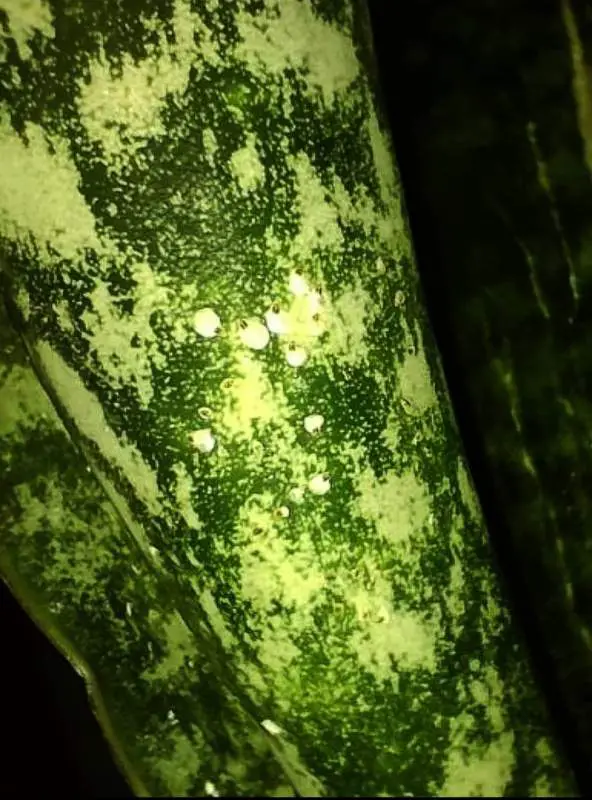
Scale on Whale Fin Snake Plant
Thrips Pests
Thrips are particularly difficult pests to get rid of. The best way to get rid of thrips is to use a systemic insecticide. Add 1 teaspoon of systemic insecticide per gallon of water and water the plant. The plant will absorb insecticide through the water. As thrips feed on the plant, they will ingest the insecticide and die.
Diseases
The most common diseases that affect Whale Fin plants are fungal Red Leaf Spot and Southern Blight as well as bacterial Soft Rot (Erwinia carotovora). Red leaf spot (Fusarium leaf spot) is characterized by reddish-brown lessions, oftentimes with a yellow border, that usually occur on young leaves. The lesions occur when the leaves are wet and fungal spores are present. If your plant is infected, treat it with a fungicide and keep the foliage dry.
Southern Blight (Sclerotium rolfsii) is characterized by water-soaked necrotic lessions on leaves near the soil. The lesions lead to stem rot and wilting. Diseased plants should be discarded.
Bacterial soft rot is relatively frequent during propagation. It is characterized by mushy soft rot of the lower end of leaves, sometimes with a fishy, rotten odor. To prevent soft rot infections, make sure the plant leaves stay dry.
Common Problems with Sansevieria Masoniana
Shriveled Leaves
Shriveled leaves are caused by underwatering. Water the Whale Fin Sansevieria plant, make sure the soil is fully saturated. After a day or two, the leaves should return to normal.
Soft and mushy leaves
Soft and mushy leaves are usually a sign of root rot caused by overwatering. If your Whale Fin Sansevieria has soft and mushy leaves, take it out of the pot. Remove all soil and cut off all soft and mushy roots. Repot in a fresh well-drained potting mix. And place the plant in the brightest spot in your home.
Tips To Grow Sansevieria Masoniana Problem Free
Here are the best tips to grow Sansevieria Masoniana without problems. If you stick to these Whale Fin Sansevieria care tips, you are unlikely to experience any problems:
- Keep the plant in bright light, over 750 lux (75 foot candles). Ideal lighting conditions would be light over 10,000 lux with a few hours of early morning direct sun.
- Pot in a well-draining mix that’s not compacted and has a lot of oxygen for the roots.
- Water once the soil is 100% dry
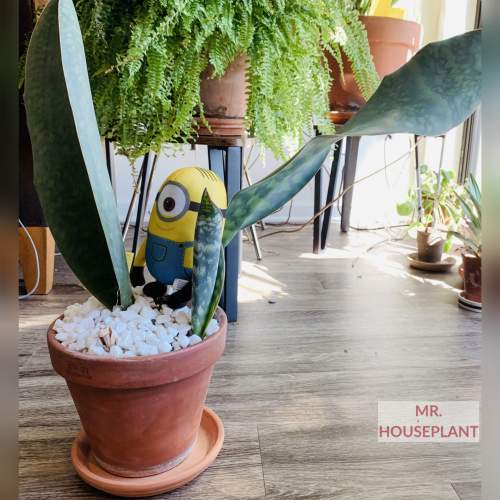
Snake plant in bright light
FAQ
I Bought A Sansevieria Masoniana Several Months Ago And It Hasn’t Grown Since. What Am I Doing Wrong?
You are not doing anything wrong. Sansevieria Masoniana grows very slowly. It can take from several months to 1 year for another leaf to grow. To increase the speed of growth, increase the amount of light your plant is getting.
Why Is My Whale Fin Plant Curling?
The most common reason for your Whale Fin curling is lack of soil moisture. Your plant was left dry for too long and is underwatered. Whale Fins can go for a long time without water, but if left without water for too long, the leaves will start curling. To correct this, top water your plant several times in a row or bottom water it. The leaves should uncurl in about 24 hours.
Is Whale Fin Sansevieria an Indoor Plant?
Yes, Whale Fin Sansevieria is an indoor plant. You can keep it in your home, just make sure to keep it in front of a bright window for the best results. Even though it’s low light tolerant, bright light will help it photosynthesize more and grow bigger.
How Big Can Whale Fin Plants Get?
If given proper care, Whale Fin plants can grow to be up to 3 feet tall.
What Are Whale Fin Snake Plant Benefits?
The biggest benefit of a Whale Fin Snake Plant is its ability to improve air quality and promote the healing of infected wounds. The following research illustrates these points. A 1989 NASA study, conducted by B.C. Wolverton, titled “Interior Landscape Plants For Indoor Air Pollution Abatement” demonstrated that snake plants are effective at removing toxins such as formaldehyde and benzene from the air, which can improve overall air quality. A 2018 study conducted by Yos Adi Prakoso from the Faculty of Health, University of Muhammadiyah Sidoarjo, Indonesia, demonstrated that Whale Fin Snake Plant has the potential effects to promote the healing of infected wounds.
Even though snake plants clean air, in order for you to see a benefit in air quality, you would need to have tens or even hundreds of large snake plants in your home.
Another benefit of Whale Fin Snake plant is that they are great plants for beginner plant parents. What makes them so beginner-friendly is that they tolerate low light and can go for long periods without water. Although they can tolerate low light, don’t expect them to thrive in such an environment.
Is Whale Fin Sansevieria Rare?
Yes, Whale Fin Sansevieria is considered to be rare. You can find smaller plants or one-leaf plants rather easily. Adult plants, or plants with several leaves are not easy to find. Variegated Whale Fin plants are even rarer.
Why are Whale Fin Plants So Expensive?
Whale Fin Sansevieria are so expensive because of their rarity and slow speed of growth. Adult plants and plants with several leaves are not easy to find. Also, it can take up to 12 months for one new leaf of Whale Fin Snake Plant to grow. Due to the long time it takes them to grow to adult size, they can reach high prices.
How Long Will It Take For The Second Leaf To Grow?
It can take from several months to 1 year to grow a second leaf. Whale Fin Snake Plant is a slow growing plant.
Why Is The Second Leaf Smaller Than The First One?
The second leaf is smaller due to either lack of light, lack of water, or the plant being root bound. If your Whale Fin Sansevieria hasn’t been getting enough light during the previous months, new leaves will grow smaller. If your plant did get enough light, but the leaf is small, the second most common reason is lack of water. If it was dehydrated during the period of growth of the second leaf, the cells weren’t able to expand to their maximum size, and the leaf stayed small. If the Whale Fin Sansevieria was getting enough light and water, the last reason for the leaf growing small is that it was root bound. Repot the plant to a bigger pot to give the roots more space. If the second leaf stopped growing, this will not increase its size. But it will give the opportunity for new leaves to grow larger.
Is Sansevieria Masoniana a Succulent?
Yes, Sansevieria Masoniana is a rhizomatous, succulent perennial. Like other snake plant varieties, its thick leaves and roots store water.
Is The Plant Called Sansevieria Masoniana or Dracaena Masoniana?
Snake plants are now categorized under the Dracaena genus, so the proper name for Sansevieria Masoniana is now Dracaena Masoniana.
More Questions on Whale Fin Sansevieria Care?
If you have more questions on Whale Fin Sansevieria care or other house plants, schedule a talk with me. I’m always happy to help!
Yours Truly,

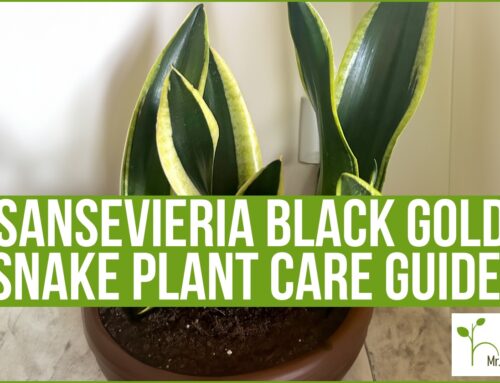




Have this Dracaena for 13 years. Seller had 5 plants with no identification. Finally, with help, think this may be a a Dracaena masonina, variegated. It put up a flower spike and I will try to attach the photo.
Leaves are 1.5 meters, flower is round (14”x12”) and smells like grapefruit
Am I on the right track for the ID of the species name? Thanks Sherry
Can’t paste the picture. Let me know an alternate way to send a picture.
Grateful for your assistance.
Have this Dracaena for 13 years. Seller had 5 plants with no identification. Finally, with help, think this may be a a Dracaena masonina, variegated. It put up a flower spike and I will try to attach the photo.
Leaves are 1.5 meters, flower is round (14”x12”) and smells like grapefruit
Am I on the right track for the ID of the species name? Thanks Sherry
Can’t paste the picture. Let me know an alternate way to send a picture.
Grateful for your assistance.
Hi Sherry, I will look at the photos you sent me and try to figure out the name of the plant you have